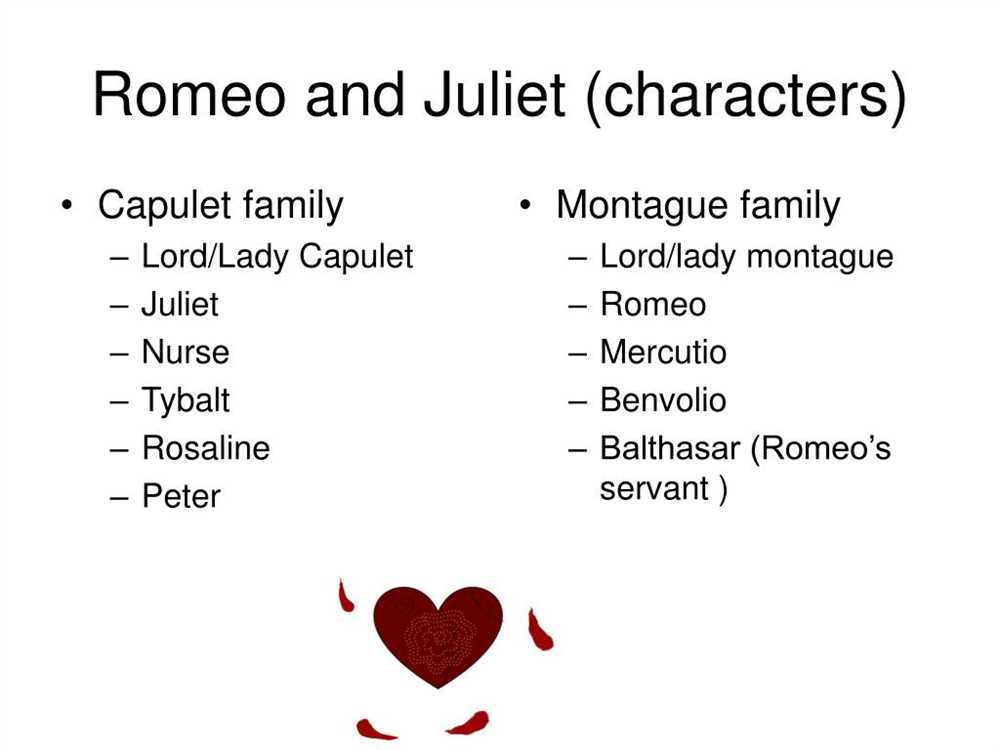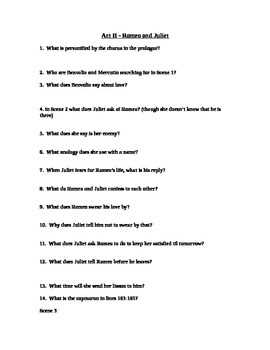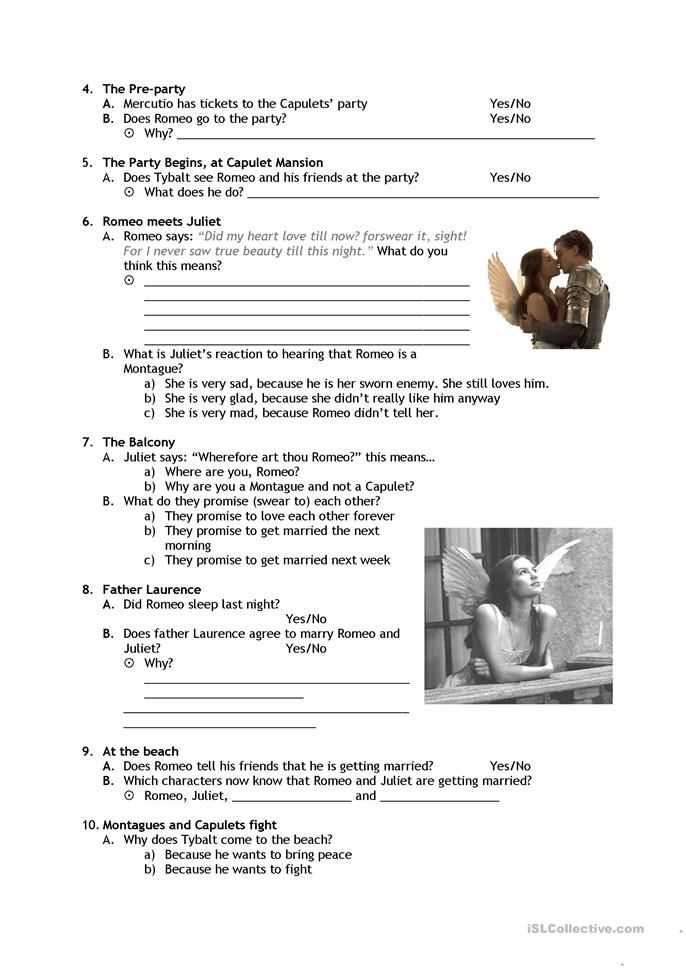
If you are studying Romeo and Juliet and need answers to your viewing guide, you have come to the right place. This guide will provide you with detailed answers to the questions in the 2013 film version of Romeo and Juliet. Whether you are a student looking to understand the film better or a teacher seeking to facilitate classroom discussion, this guide will help you navigate through the key points of the movie.
The 2013 film adaptation of Romeo and Juliet, directed by Carlo Carlei, brings Shakespeare’s timeless tragedy to life on the big screen. With a talented cast including Hailee Steinfeld as Juliet and Douglas Booth as Romeo, the film stays true to the original play while adding its own artistic flair. As you watch the movie, this viewing guide will help you make sense of the plot, analyze characters, and explore the themes and motifs that make Romeo and Juliet a beloved classic.
Throughout the guide, you will find answers to questions such as: “How does the film portray the feud between the Montagues and the Capulets?”, “What choices did the director make in terms of setting and costume design?”, and “How does the film depict the famous balcony scene?”. By providing in-depth answers to these questions and more, this guide aims to enhance your understanding and appreciation of the 2013 film adaptation of Romeo and Juliet.
Romeo and Juliet Viewing Guide: Important Questions and Answers
When watching the 2013 adaptation of Romeo and Juliet, it is important to keep in mind the key questions that arise from the play. This viewing guide provides answers to some of these important questions, giving viewers a deeper understanding of the film.
1. How does the film portray the theme of love?
In the film, love is depicted as both passionate and destructive. The intense love between Romeo and Juliet is shown through their longing gazes and tender embraces. However, this love also leads to tragedy, as their families’ feuds ultimately result in their untimely deaths. Through the portrayal of love, the film explores the power and consequences of passion.
2. What is the significance of the costumes and set design?
The costumes and set design in the film play a crucial role in establishing the time period and atmosphere of the story. The costumes reflect the Renaissance era, with characters wearing elaborate dresses, doublets, and ruffled collars. The set design, on the other hand, features grandeur and opulence, with sprawling gardens and towering halls. These visual elements contribute to the overall authenticity and aesthetic appeal of the film.
3. How are the characters developed in the film?
The film provides nuanced portrayals of the characters, giving them depth and complexity. Romeo is shown as a passionate and impulsive young man, while Juliet is portrayed as a vulnerable yet strong-willed woman. Other characters, such as Mercutio and Tybalt, are given distinct personalities and motives. Through their development, the film highlights the multidimensional nature of these iconic characters.
4. What is the director’s interpretation of the play’s ending?
The director’s interpretation of the play’s ending in the film stays true to Shakespeare’s original tragedy. The final scene showcases the tragic fate of Romeo and Juliet, emphasizing the consequences of their actions and the cycle of violence perpetuated by their families. The director uses cinematography and music to heighten the emotional impact of their deaths, leaving a lasting impression on the viewers.
5. How does the film explore the theme of fate?
Fate is a recurring theme in the film, with several instances of foreshadowing and coincidences. The introduction of a fortune-telling machine adds a supernatural element to the story, suggesting that the fate of Romeo and Juliet was predetermined. This exploration of fate adds a layer of inevitability to their tragic love story, highlighting the power it has over their lives.
- Overall, the 2013 adaptation of Romeo and Juliet delves into the complexities of love, fate, and the human condition.
- Through its visual and narrative choices, the film brings a fresh perspective to the timeless tale of the star-crossed lovers.
Exploring the Key Themes and Motifs
As we delve into the world of Romeo and Juliet, it is important to examine the key themes and motifs that Shakespeare weaves throughout the play. These recurring elements not only add depth and complexity to the story, but also provide insight into the characters and their motivations.
Love and Fate

One of the central themes in Romeo and Juliet is the power of love and its tragic consequences. From the moment Romeo and Juliet lay eyes on each other, they are consumed by a passionate and all-consuming love that transcends societal boundaries. However, their love is ultimately overshadowed by the cruel hand of fate, as their families’ bitter feud and the forces of destiny conspire against them.
- Love: Romeo and Juliet’s love is portrayed as powerful and transformative, capable of transcending societal divisions and inspiring extraordinary sacrifices.
- Fate: Throughout the play, references to fate and destiny remind us of the tragic outcome that awaits the young lovers.
- Love vs. Hate: The theme of love versus hate is highlighted through the feuding families, the Montagues and the Capulets, whose hatred for each other ultimately leads to tragedy.
Identity and Masculinity
Another important theme in Romeo and Juliet is the exploration of identity and masculinity. The characters in the play often grapple with societal expectations and struggle to define themselves within their prescribed roles.
- Identity: Romeo and Juliet both struggle with the expectations placed upon them by their families and society, highlighting the theme of self-identity.
- Masculinity: The concept of masculinity is examined through the characters of Romeo and Tybalt, who embody different aspects of masculinity and clash due to their conflicting identities.
- Gender Roles: The play challenges traditional gender roles, with Juliet being portrayed as a strong, independent woman who defies societal expectations.
Light and Dark Imagery
A recurring motif in Romeo and Juliet is the use of light and dark imagery to convey emotions and foreshadow events. This motif adds depth and symbolism to the play, often mirroring the characters’ internal struggles.
- Light: Light is often associated with love, purity, and life. It is used to symbolize the beauty and intensity of Romeo and Juliet’s love for each other.
- Darkness: Darkness is frequently linked to death, violence, and despair. It foreshadows the tragic fate that awaits the young lovers.
- Balcony Scene: The famous balcony scene is a prime example of the light and dark imagery, as Romeo compares Juliet’s beauty to the brightness of the moon and the stars.
Romeo and Juliet: Understanding the Historical Context
The play “Romeo and Juliet” by William Shakespeare is set in Verona, Italy during the 16th century. It is important to understand the historical context in which the play takes place in order to fully appreciate the events and motivations of the characters.
During the time period in which the play is set, Italy was divided into numerous city-states. Verona, where the play is primarily based, was a prosperous city-state ruled by the Prince. This setting provides a backdrop of political instability and conflict, which is mirrored in the feuding between the Montague and Capulet families. The feud between these two families dates back several generations and adds to the tension and tragedy of the play.
The society in which Romeo and Juliet live is deeply hierarchical, with strict social and gender roles. The upper class, represented by the ruling families, held wealth and power, while the lower classes, such as the servants, had less status and were often disregarded. The patriarchy is also evident, as Juliet is expected to obey her father’s wishes and marry according to his choice. These societal norms and expectations play a significant role in the plot and the actions of the characters.
Key Historical Concepts:

- City-states and political instability
- Feuding between noble families
- Social hierarchy and class divisions
- Gender roles and patriarchy
By understanding the historical context of “Romeo and Juliet,” we can gain a deeper insight into the motivations and struggles of the characters. It allows us to appreciate the complexities of the society in which they lived and how it ultimately contributes to their tragic fate.
Unraveling the Feud between the Montagues and Capulets
The feud between the Montagues and Capulets is one of the central conflicts in Shakespeare’s play, “Romeo and Juliet.” The origin and nature of this feud remains a mystery, but its effects are felt throughout the story. Both families are prominent and powerful in Verona, and their rivalry has led to violence and bloodshed.
While the exact cause of the feud is unknown, it is clear that it has deep roots and has been passed down from generation to generation. The animosity between the Montagues and Capulets is so ingrained that the young members of both families are not even sure why they are supposed to hate each other. This blind hatred and loyalty to their respective families eventually leads to tragedy.
The Montagues and Capulets are both wealthy and influential families, which adds to the intensity of their conflict. Each family seems to be driven by a desire to protect their reputation and maintain their status in society. This leads them to engage in frequent clashes, whether it be in street brawls or verbal confrontations.
- The feud between the Montagues and Capulets highlights the destructive power of hatred and the consequences of holding onto grudges.
- Both families suffer immense loss as a result of their feud, ultimately recognizing the futility and senselessness of their actions.
- The conflict between the Montagues and Capulets serves as a backdrop to the love story of Romeo and Juliet, emphasizing the tragic consequences of their forbidden love.
- It also serves as a commentary on the larger societal issues of division and conflict.
In conclusion, the feud between the Montagues and Capulets in “Romeo and Juliet” is a complex and multifaceted conflict that drives the narrative of the play. Its origins may never be fully understood, but its impact on the characters and the story is undeniable. The tragedy of the play serves as a cautionary tale about the destructive power of hatred and the importance of reconciliation and understanding.
Analyzing the Characters in Romeo and Juliet
Romeo and Juliet is a tragic love story written by William Shakespeare, and it features a rich ensemble of complex characters. Each character plays a vital role in shaping the events of the play, and their personalities, motivations, and actions drive the plot forward.
Romeo Montague: Romeo is the young and impulsive protagonist of the play. He is a romantic idealist who falls deeply in love with Juliet at first sight. Romeo’s character is characterized by his passionate nature, his tendency to act on his emotions, and his willingness to risk everything for love. However, his impulsive actions ultimately lead to tragedy and his untimely death.
Juliet Capulet: Juliet is the young and innocent daughter of the Capulet family. She is portrayed as mature beyond her years and possesses a strong-willed and independent nature. Juliet’s character undergoes a significant transformation throughout the play, as she defies her family’s expectations and chooses to be with Romeo. Her love for Romeo is unwavering, and she is willing to risk everything, including her own life, to be with him.
Lord Capulet: Lord Capulet is Juliet’s father and a prominent member of the Capulet family. He is a powerful and respected figure in Verona, and his character embodies the societal expectations and pressures of the time. Lord Capulet is initially portrayed as a caring and protective father, but his strictness, pride, and short temper contribute to the tragedy of the play. His insistence on Juliet’s marriage to Paris and his subsequent anger towards her when she defies him further fuel the conflict.
Lord Montague: Lord Montague is Romeo’s father and the patriarch of the Montague family. Unlike Lord Capulet, Lord Montague is more reserved and restrained in his actions. He is deeply concerned about Romeo’s melancholy and infatuation with Rosaline, but he ultimately wants his son to find happiness. Lord Montague’s character represents the peaceful and rational side of the feud between the Montague and Capulet families.
Mercutio: Mercutio is Romeo’s close friend and a relative of the Prince of Verona. He is known for his wit, humor, and bawdy behavior. Mercutio serves as a foil to Romeo’s romanticism, as he believes in the power of reason and mocks Romeo’s lovesickness. Mercutio’s untimely death at the hands of Tybalt sparks a chain of events that leads to the tragic downfall of Romeo and Juliet.
Examining the Complexity of Romeo and Juliet’s Relationship
The relationship between Romeo and Juliet in Shakespeare’s play is complex and multi-faceted. This iconic love story is not just a simple tale of two young people falling in love, but rather a reflection of the complexities of love, fate, and societal expectations. The characters of Romeo and Juliet are deeply intertwined, both emotionally and intellectually, and their relationship evolves throughout the play.
One of the key aspects of their relationship is their intense and passionate love for each other. From the moment they meet, there is an instant and undeniable connection between them. They are drawn to each other like magnets, unable to resist the powerful force that pulls them together. Their love is characterized by its intensity and desperation, as they are willing to risk everything, even their lives, to be together. This intense love is exemplified in Romeo’s famous line, “Did my heart love till now? Forswear it, sight! For I ne’er saw true beauty till this night.”
However, the complexity of their relationship also stems from the obstacles they face. Their families are bitter enemies, and their love is forbidden. The societal expectations and pressure put a strain on their relationship, adding a layer of tension and conflict. Their love is constantly tested by the outside world, and they are forced to make difficult choices and sacrifices in order to be together.
Furthermore, their relationship is also influenced by the theme of fate. They are portrayed as star-crossed lovers, destined for tragedy from the beginning. Despite their best efforts to defy fate and rewrite their own story, they ultimately succumb to the predetermined path set out for them. This adds a sense of inevitability and tragic irony to their relationship.
In conclusion, the relationship between Romeo and Juliet is a complex and multifaceted one, characterized by intense love, societal pressures, and the influence of fate. Their story serves as a powerful exploration of the complexities and contradictions of love, and the struggles that come with it.